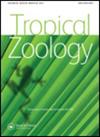Colony site characteristics of sympatric breeding tern species on the Mond Islands, the Persian Gulf
IF 0.4
4区 生物学
Q4 ZOOLOGY
引用次数: 1
Abstract
We have investigated characteristics of colony site of three sympatric breeding tern species on small islands of a subtropical region, the Persian Gulf. The three most populous ground-nesting waterbird species – Bridled Tern Onychoprion anaethetus, Lesser Thalasseus bengalensis and Greater Thalasseus bergii Crested Terns – were studied during the 2009–2011 breeding seasons. The average area size of mixed colonies was 454 m2. The density of nests of the Bridled Tern was 846 nests/ha. The proportion of the number of nests in a mixed colony for Lesser Crested Tern (5546 nests) was approximately 10-fold compared to the Greater Crested Tern (542 nests). The density of Bridled Tern nests/ha was significantly higher in areas with 50–75% vegetation cover (>1200 nests/ha) than in areas of <5% vegetation cover (72–105 nests/ha) (p < 0.05). Mixed colonies of the Lesser and Greater Crested Terns were located on unvegetated land, at an average distance of 4.1 m to vegetation, and on sandy soil (79.4% on average) and above high spring tide water lines (0.59 m on average). There were more potential nesting areas than occupied areas for the mixed colonies of the Lesser and Greater Crested Terns, indicated that they did not face nest site limitation. https://zoobank.org/urn:lsid:zoobank.org:pub:7523ABA7-45E1-4067-8EF7-557E65EC8249波斯湾蒙德群岛同域繁殖燕鸥种群的栖地特征
我们调查了三种同域繁殖燕鸥在波斯湾亚热带小岛上的群落特征。在2009-2011年繁殖季节,研究了三种数量最多的地面筑巢水鸟物种——红毛燕鸥、孟加拉小地中海燕鸥和佛手大地中海燕鸥。混合菌落的平均面积大小为454m2。燕窝密度为846窝/公顷。与大冠燕鸥(542个巢穴)相比,小冠燕鸥混合群落中巢穴数量的比例(5546个巢穴)约为10倍。在植被覆盖率为50-75%的地区(>1200个巢/公顷),斑燕窝的密度显著高于植被覆盖率<5%的地区(72-105个巢/ha)(p<0.05)。小冠燕窝和大冠燕窝的混合群落位于未植被覆盖的土地上,与植被的平均距离为4.1米,沙质土壤(平均79.4%)和大潮高潮线以上(平均0.59m)。小冠燕鸥和大冠燕鸥的混合群落的潜在筑巢区比占据区多,这表明它们没有面临筑巢地点的限制。https://zoobank.org/urn:lsid:zoobank.org:pub:7523ABA7-45E1-4067-8 ef7-57e65ec8249
本文章由计算机程序翻译,如有差异,请以英文原文为准。
求助全文
约1分钟内获得全文
求助全文
来源期刊

Tropical Zoology
生物-动物学
CiteScore
2.50
自引率
0.00%
发文量
1
审稿时长
>12 weeks
期刊介绍:
Tropical Zoology is an international zoological journal publishing original papers in the field of systematics, biogeography, phylogeny, ecology and conservation of all terrestrial and aquatic animal Phyla from tropical and subtropical areas.
Only papers with new information, high quality and broad interest are considered. Single species description and checklists are not normally accepted. Review papers are welcome. The journal is owned by the Istituto di Ricerca sugli Ecosistemi Terrestri of the Consiglio Nazionale delle Ricerche, Florence, Italy (CNR-IRET) who performs research into the structure and functioning of aquatic and terrestrial ecosystems, focusing in particular on anthropogenic pressure and global change. The knowledge amassed forms the scientific basis for identifying the most appropriate protective and corrective interventions, and provides support for the bodies entrusted with formulating policies for environmental protection and recovery.
 求助内容:
求助内容: 应助结果提醒方式:
应助结果提醒方式:


